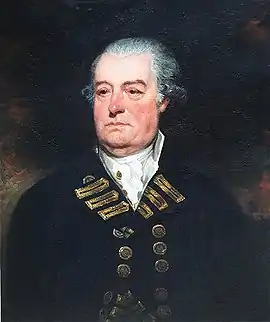Mariot Arbuthnot
Admiral Mariot Arbuthnot (1711 – 31 January 1794) was a British admiral, who commanded the Royal Navy's North American station during the American War for Independence.
Mariot Arbuthnot | |
|---|---|
 | |
| Born | 1711 Weymouth |
| Died | 31 January 1794 (aged 82–83) London |
| Allegiance | Kingdom of Great Britain |
| Service/ | Royal Navy |
| Rank | Admiral of the Blue |
| Battles/wars | Battle of Cape Henry |
| Relations | John Arbuthnot (uncle) |
Early life
A native of Weymouth, Dorset in England, Arbuthnot was the son of Robert Arbuthnot and Sarah, née Bury. Robert's father was the son of the Rev. Robert Arbuthnot, Presbyterian minister of Crichton & Cranston. Mariot Arbuthnot entered the Royal Navy in the late 1720s, became a lieutenant in 1739, and commander in 1746. In 1746 he was commander of the sloop HMS Jamaica, which captured two French privateers while employed as a cruiser in the channel. He was appointed post captain in 1747. On 22 June 1747 Arbuthnot became captain of the frigate HMS Surprize. Shortly afterwards he became captain of the Triton.
Seven Years' War
In 1757 he became chief officer of the Garland. In 1759, during the Seven Years' War, he commanded the Portland, one of the ships employed under Commodore Robert Duff in the blockade of Quiberon Bay, and was present at the total defeat of the French on 20 November. Towards the end of the war he commanded HMS Oxford. In 1770 he was made captain of HMS Terrible.
American War of Independence
_by_Dominic_Serres%252C_c._1765.jpg.webp)
From 1775 to 1778, he was Resident Commissioner of the Navy, Halifax Nova Scotia.[1][2] He was Lieutenant Governor of Nova Scotia, 1776–78. He was replaced in this role by Richard Hughes. It may have been about then that an armed schooner was named Arbuthnot after him. On 19 March 1779, he was made Vice-Admiral of the Blue,[3] and on 2 May 1779 took command of HMS Europa. That same year he took up his appointment as commander-in-chief on the North American Station.[4] Soon after arriving at his destination, he was blockaded in New York City harbour by the French fleet under Count d'Estaing.
In December 1779, Arbuthnot conveyed the troops of Sir Henry Clinton to Charleston, South Carolina, and cooperated with him in laying siege to that city. The surrender document signed by prominent citizens was addressed to him and Clinton.[5] On 26 September 1780 he was promoted to Vice-Admiral of the White.[6] On 13 March 1781, he fought the French Newport squadron, at the Battle of Cape Henry,[7] before returning to England.
Later life
He advanced by seniority to become, on 1 February 1793, Admiral of the Blue.[8] He died in London the following year, leaving two sons, John and Charles.
That he was ignorant of the discipline of his profession was proved by his altercation with Sir George Rodney; that he was destitute of even a rudimentary knowledge of naval tactics was shown by his absurd conduct of the Battle of Cape Henry; and, for the rest, he appears in contemporary stories (cf. Morning Chronicle, 18 May 1781) as a coarse, blustering, foul-mouthed bully, and, in history, as a sample of the extremity to which the maladministration of Lord Sandwich had reduced the British Navy.[9]
Admiral Arbuthnot was the nephew of Dr. John Arbuthnot, the satirist and mathematician.
References
- "No. 11583". The London Gazette. 29 July 1775. p. 1.
- "No. 11850". The London Gazette. 17 February 1778. p. 2.
- "No. 11962". The London Gazette. 16 March 1779. p. 2.
- Chard, Donald F. (1979). "Arbuthnot, Mariot". In Halpenny, Francess G (ed.). Dictionary of Canadian Biography. Vol. IV (1771–1800) (online ed.). University of Toronto Press.
- "No. 12098". The London Gazette. 4 July 1780. p. 5.
- "No. 12122". The London Gazette. 26 September 1780. p. 4.
- "No. 12181". The London Gazette. 21 April 1781. pp. 1–3. (Arbuthnot's account of the battle of Cape Henry)
- "No. 13499". The London Gazette. 2 February 1793. p. 99.
-
 One or more of the preceding sentences incorporates text from a publication now in the public domain: Laughton, John Knox (1885). "Arbuthnot, Marriot". In Stephen, Leslie (ed.). Dictionary of National Biography. Vol. 2. London: Smith, Elder & Co. pp. 65–66.
One or more of the preceding sentences incorporates text from a publication now in the public domain: Laughton, John Knox (1885). "Arbuthnot, Marriot". In Stephen, Leslie (ed.). Dictionary of National Biography. Vol. 2. London: Smith, Elder & Co. pp. 65–66.
External links
- Family tree[Usurped!]
- Arbuthnot, Mrs P S-M (1920). Memories of the Arbuthnots. George Allen & Unwin.
- The Georgian Era
- Wilson, J. G.; Fiske, J., eds. (1900). . Appletons' Cyclopædia of American Biography. New York: D. Appleton.
- Gilman, D. C.; Peck, H. T.; Colby, F. M., eds. (1905). . New International Encyclopedia (1st ed.). New York: Dodd, Mead.